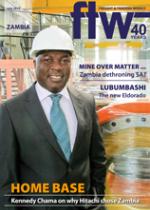Japanese firm Hitachi
Construction Machinery
Group decided to
open its first African
remanufacturing centre
in Lusaka because of the
geographic centrality of the
country. The project aim is to
have components brought in
from throughout the region –
including South Africa – for
remanufacturing to “as good
as new” standard, according to
Kennedy Chama, planning and
logistics manager for Hitachi
Construction Machinery Zambia.
The company’s
Remanufacturing Centre is
being utilised by a number of
mines in the region, including
the Canadian-owned Lumwana
mine in Zambia, which is Africa’s
largest copper mine; First
Quantum Minerals Limited also
located in the North Western
Zambia; the Konkola Copper
Mines plc; and the giant Moatize
coal mine in Mozambique which
is operated by Vale of Brazil.
With the mining boom in
southern Africa and
the positive trends
in investment in
this sector, there
are strong
demands
for parts
components
to support the
equipment
already
in the
field, says Chama. Because of this
huge demand in the region and
the company’s policy in offering
high levels of customer support,
Hitachi invested US$15 million
in the Lusaka plant to ensure
the availability of replacement
components. In addition to
ensuring the availability of
components for models in the
field, “remanufacturing is more
environmentally friendly than
always using new components,”
he says. Hitachi adopted the
globally accepted principle of
recycling cores and casings
which are still within standard
specifications and
replacing the inner
parts with new ones.
For high
reliability and
equipment availability, Hitachi
remanufactured components are
of high quality and are backed
by the same warranty as the
“new parts”
warranty policy
but offered at
a significantly
lower price,
Chama told
FTW. “And the
Lusaka facility
has a record
of zero premature failures since
operations started in June 2012,”
he said.
The more than 30 technicians
working in the plant are mostly
Zambian, in line with Hitachi’s
policy to promote local economic
development. Machinery used in
the plant was imported directly
from Japan, and
measuring and
testing equipment
from South Africa.
The Zambian
government
facilitated this
investment with
start-up incentives
including the
waiving of
import duty on
manufacturing
equipment, which
was another factor
that inf luenced
Hitachi’s decision to become
the first major Japanese private
company to invest in Zambia.
To carry out its
remanufacturing
business
successfully,
Hitachi
Remanufacturing
Centre imports
and stocks a huge
volume of parts
of over 3 400 line
items valued at over US$14 m in
the company’s Lusaka warehouse.
These stocks are replenished
through a combination of
direct shipments from Hitachi
Construction Machinery HCM
in Japan, and Hitachi Truck
Manufacturing HTM in Canada,
through Durban and Beira. There
is also quite a significant amount
of airfreighting for urgent parts,
says Chama.
There are deliveries from
Hitachi Construction Machinery
Africa in Jet Park, Gauteng
three times a month on
current average, he added. The
Lusaka warehouse supplies the
Hitachi warehouses with the
remanufactured components
in the Copperbelt, with weekly
deliveries to Kitwe and Lumwana
so that remanufactured
components are stocked near the
mine site operations.
INSERT
$14m The value of the more than 3 400
line items stored in the Hitachi
Remanufacturing Centre.
INSERT & CAPTION
One of the biggest
challenges in the region
is not the transporting of
the large components,
which can weigh tons, but
negotiating through the
different tax regimes in the
neighbouring countries.
– Kennedy Chama
CAPTION
The new high-profile Hitachi Construction Machinery remanufacturing plant in Lusaka.

